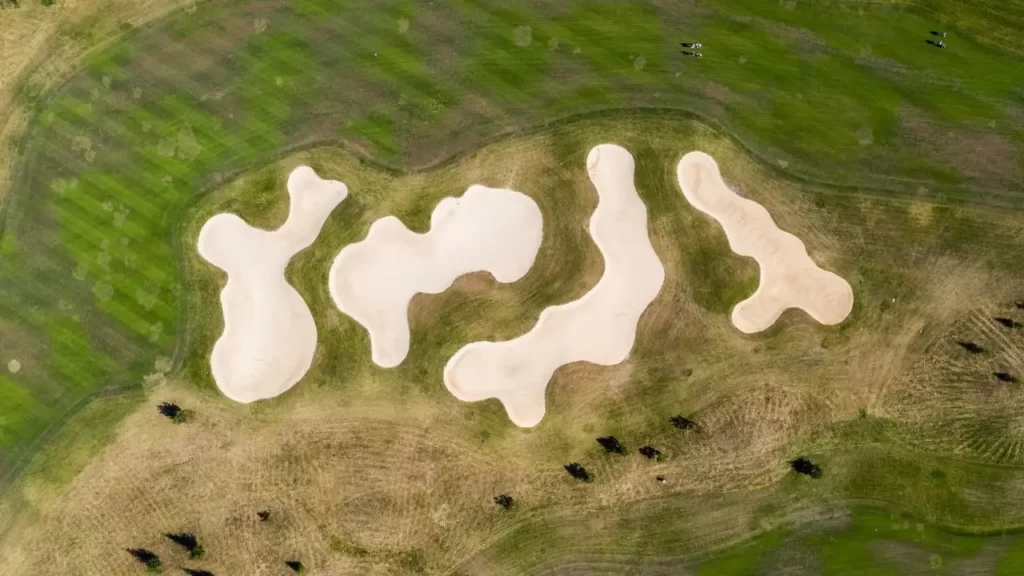Golf Course Management Tips for Challenging Terrains
Enhance your golf performance with effective golf course management. By selecting the right club, calculating wind speed and direction, and strategically avoiding hazards, you can significantly lower your scores. Aim for accuracy rather than distance, choose an appropriate club for each shot, and consider playing it safe when necessary. Remember, every shot counts. So, plan wisely and play to your strengths for an improved golf game.

Key Takeaways
- Golf course management is essential for improving your golf game, focusing on strategic decisions to maximize shot quality and minimize trouble.
- Approach shot club selection is critical; consider factors like distance, hazards, and wind to choose the right club for each shot.
- Use the driver selectively based on tee box placement, wind, and hole layout; sometimes, a fairway wood or hybrid is a better choice.
- Play away from trouble areas instead of attempting risky hero shots, minimizing your scorecard and staying competitive.
- When facing recovery shots, prioritize smart and safe plays over heroic attempts, using the right club and technique to save strokes.
Introduction
Golf is one of the most challenging and rewarding sports out there. It requires a lot of skill, patience, and strategy. Golf course management is a crucial aspect of the game that many players tend to overlook.
Proper course management can help you lower your scores and improve your golf game. Understanding Golf Course Management
Golf course management involves making strategic decisions on the golf course that maximize your chances of hitting quality shots while avoiding trouble. This includes selecting the right club for each shot, choosing an appropriate target, and playing to your strengths.
One common mistake that many amateur golfers make is trying to hit their shots as far as possible without regard for accuracy or placement. This can lead to trouble off the tee, in bunkers or hazards, or even on approach shots where landing on the green becomes difficult.
The Importance of Approach Shot Club Selection Another crucial aspect of golf course management is selecting the right club for approach shots.
Many amateur golfers make the mistake of relying solely on distance when choosing their approach shot club rather than considering factors such as wind speed and direction, lie angle and elevation changes. Choosing an appropriate club can be especially important when facing difficult approach shots, such as those with narrow fairways or hazards in play.
"Golf course management involves making strategic decisions on the golf course that maximize your chances of hitting quality shots while avoiding trouble. One common mistake that many amateur golfers make is trying to hit their shots as far as possible without regard for accuracy or placement. Proper course management can help you lower your scores and improve your golf game."
A wedge or fairway wood may be more appropriate than a long iron or hybrid since these clubs offer greater control over distance and trajectory. The Role of the Driver
The driver is one of the most important clubs in a golfer’s bag, but it should only be used selectively depending on factors such as tee box placement, wind conditions, hole layout, and par rating. In general, though, it should only be used if necessary to get maximum distance off tee boxes where its power can propel balls toward landing zones within range for an easily playable second shot with shorter clubs like irons or hybrids.
Playing Away from Trouble Another key aspect of golf course management is playing away from trouble instead of trying to be a hero and hitting miraculous shots out of trouble areas.
Enjoying this article? Read more:
Check out this video below from Golf Monthly‘s Youtube channel:
Rather than taking on risky shots such as trying to hit over water hazards or bunkers, it is often better to play a safe shot that avoids trouble. This can help you minimize your scorecard and keep you in the game.
By adopting a strategic game plan that takes into account your strengths and weaknesses as well as the course layout, distance, and conditions, golfers can improve their golf performance by making better decisions on the course. The following sections of this article will delve into more specific tips for managing different types of holes and shots.

Understanding Golf Course Management
Golf course management is all about using the right strategies and techniques to play your best game and lower your scores. It’s not just about hitting the perfect shot or having the latest golf equipment; more importantly, it’s about making informed decisions on each hole by analyzing the terrain, hazards, and conditions.
Here are some key elements of golf course management that can give you a competitive edge: One of the most important aspects of golf course management is the approach to shot club selection.
Many golfers make the mistake of always going for their highest-lofted club when they’re close to the green, regardless of how far away they are or what kind of trouble lies ahead. A better approach is to consider both distance and accuracy when choosing which club to use.
For example, if you’re only a few yards away from landing on the green with your 6-iron but there’s a bunker in front of you, it may be smarter to use a 7-iron instead and aim for the middle of the green. Another crucial part of game management is tee-shot strategy.
It’s easy to get carried away with trying to hit long drives straight down the fairway every time you tee off, but sometimes a more conservative approach can help you avoid trouble and set yourself up for better shots later on. For example, if there’s water or thick rough in front of you on a par-5 hole, it might be wiser to hit a shorter drive that avoids those hazards rather than trying to power through them.
"Golf course management is not just about hitting the perfect shot; it's about making informed decisions on each hole by analyzing the terrain, hazards, and conditions. Many golfers make the mistake of always going for their highest-lofted club when close to the green, but a better approach considers both distance and accuracy."
When playing competitive golf as opposed to recreational rounds with friends or family members who aren’t as experienced at this sport as you are, it’s also important not to get too caught up in hero shots or try too hard to recover from bad shots or misses. Sometimes it’s better just to take your medicine and take safe shots that minimize risk rather than risking even more trouble by trying to pull off a miracle shot.
By keeping your composure and avoiding unnecessary risks, you can often save strokes and stay in the game. One of the most challenging aspects of golf course management is dealing with bunkers.
Whether you’re trying to get out of a greenside bunker or avoid one altogether on a tee shot, it takes practice and skill to use stroke-saving techniques that help you stay on track toward your goal of improving your golf game and lowering your scores. Some tips for dealing with bunkers include using high-lofted wedges for better control, hitting down on the ball to get it up quickly, and practicing bunker shots regularly so that they become second nature when you need them most.
Enjoying this article? Read more:

The Importance of Approach Shot Club Selection
When it comes to golf course management tips, nothing is more important than approach shot club selection. After all, the approach shot is where you get your chance to make a birdie or par, and making the right choice of club can be the difference between a good score and a bad one. Here are some things to keep in mind when selecting your club:
First of all, consider the distance you need to hit the ball. This will depend on your tee position and any hazards that may be in play.
Take note of any bunkers or water that lie between you and the green, as these will affect what sort of shot you need to play. Next, think about your golfing skills—what’s your favorite shot?
If you’re comfortable with a particular wedge or iron, use it! It’s better to go with something you know well than try to force a shot with a new club.
Another factor to consider is wind speed and direction; headwinds will slow down your shots, while tailwinds can give them extra distance. Keep an eye on the flags around the course for clues as to which way the wind is blowing.
Take into account the slope of the ground leading up to the green. If there’s an uphill climb ahead, for example, you may want to choose a slightly stronger club than usual so that you don’t come up short.
All in all, choosing the right approach to the shot club is all about making careful decisions based on factors such as distance, skill level, and environmental conditions. Practice and attention paid towards golf strategy and golf practice sessions oriented around decision-making abilities under stress and pressure scenarios can help improve golf performance immensely, which will lead to lower scores on the scorecard at the end of the day!

The Role of the Driver
When it comes to golfing, the driver is the most exciting club in your bag. It’s the club that can potentially take you 300 yards down the fairway and set you up for an easy approach shot. But do not let its potential to awe you put too much pressure on your swing.
The key is to use your driver strategically and selectively. The initial mistake that many golfers make is trying to hit their driver on every hole, no matter what.
But sometimes, it’s better to leave it in the bag and opt for a fairway wood or hybrid instead. For example, if you are playing a tight hole with hazards all over the place, a fairway wood may be your best bet, as it provides more control and accuracy than a driver.
When using your driver, aim is key. Before teeing off on each hole, identify where you want the ball to land and aim for that spot by aligning yourself accordingly.
Another tip is to tee up higher than usual, which can help increase the height of your shot and provide more carry distance. Don’t forget about wind when using your driver either; it can drastically affect how far your ball will travel.
"The driver is the most exciting club in your bag, with the potential to take you 300 yards down the fairway. However, the key is to use it strategically and selectively. Don't get too hung up on hitting perfect drives every time; game management and strategic choices are just as vital. With experience comes confidence, making the driver a powerful weapon in your golf bag."
To counteract this, try teeing up on the side of the tee box opposite where the wind is blowing from. This will allow you to hit into a crosswind rather than against it.
Don’t get too hung up on hitting perfect drives every time; often times just getting yourself in play with an adequate drive will set you up well for stroke-saving techniques such as solid iron shots or chipping close to landing on the green, where putting becomes easier. Improving game management around these kinds of decisions adds a level of strategy that requires practice both with golf equipment choices and swing improvement through golf practice sessions at driving ranges or simulators.
Enjoying this article? Read more:
Check out this video below from Scratch At 50‘s YouTube channel:
With experience comes confidence, which then leads to establishing those favorite shots, especially when competing professionally or in amateur tournaments. Once you build up that confidence, you will find that the driver can be one of the most powerful weapons in your golf bag.
Enjoying this article? Read more:

Playing Away from Trouble
Golf is a game of precision, and sometimes the smartest strategy is to play it safe.
When you find yourself in a tricky situation on the course, it can be tempting to try an ambitious shot that could get you out of trouble and back into contention. However, taking unnecessary risks often leads to costly mistakes that can ruin your round.
So, what should you do when you’re in trouble? The key is to assess the situation and make a smart decision based on your skill level and current score.
For example, if you’re facing a difficult lie in the rough or behind a tree, it may be better to simply chip out onto the fairway instead of trying to hit a miracle shot. This will give you a better chance of hitting the green with your next approach shot.
Another effective stroke-saving technique is to use fairway woods instead of long irons when playing away from trouble. Fairway woods have larger heads and are designed for longer shots, making them better suited for getting out of tough situations like deep rough or bunkers.
With practice, you can learn how to hit these clubs with accuracy and confidence and use them as an alternative option when faced with challenging lies. When deciding which club to use for your approach shot after playing away from trouble, consider using wedges for greater control around the green.
"Golf is a game of precision, and sometimes the smartest strategy is to play it safe. Taking unnecessary risks often leads to costly mistakes. When you're in trouble, assess the situation and make a decision based on your skill level and score. Sometimes, simply chipping out or using fairway woods can be the best approach."
Wedges have higher lofts than irons and are ideal for short shots that require precision and spin control. With proper golf practice, improving your short game will help lower your scores by enabling you to get up and down more frequently.
Keep in mind external factors such as wind direction when considering playing away from trouble strategically. If a strong crosswind blows against your ball’s flight path towards where danger lies on one side (e.g., a water hazard), aim in another direction where there’s more room or a sheltered area if possible.
By following these tips for playing away from trouble, you can improve your golf game and avoid unnecessary strokes. Remember that sometimes the smartest decision is to take the safe route and live to fight another hole.

Recovery Shots: Don't Be a Hero
When you find yourself in a tough spot on the course, it can be tempting to go for the hero shot. But when it comes to recovery shots, don’t be a hero.
Instead, play smart and safe shots that will help you save strokes. One of the first things to consider when playing a recovery shot is the situation you’re in.
Take a moment to assess your surroundings and think about your options. Are you in a bunker?
Buried deep in the rough? Or maybe behind a tree?
Once you’ve determined what kind of shot you need to make, it’s time to choose your club. When selecting your club for a recovery shot, aim for accuracy instead of distance.
A shorter club with more loft can help get the ball up and out of trouble easier than a longer club with less loft. And don’t forget how wind might affect your shot!
Once you’ve selected your club, take some practice swings to get comfortable with how it feels and how far it will carry. Imagine yourself hitting the ball onto the fairway or landing on the green as part of your game plan.
When making your actual stroke, remember that aim is key. Rather than trying to hit an impossible shot that might end up doing more harm than good, aim for an open area where you have more room for error, like back onto the fairway rather than directly toward the pin if it means avoiding bunkers or other hazards.
By playing smart and safe recovery shots instead of trying to be a hero every time, you’ll be able to save strokes and improve your golf performance over time. These tips are essential parts of any golfer’s game plan and golf course management tips!
Enjoying this article? Read more:

Strategy for Par 3s
When it comes to par-3s, strategy is key. These holes offer the perfect opportunity to shave a stroke off your scorecard, but they can also bring your round crashing down if you’re not careful.
Here are a few tips to help you improve your game management on par 3s. First of all, take a close look at the tee position and the pin placement.
You want to aim for the center of the green, where you have the most margin for error. If the pin is tucked away in a corner of the green or near a hazard, consider playing more conservatively and aiming for the middle of the green with a club that will get you there safely.
Next, pay attention to wind conditions. A strong crosswind can wreak havoc on your shot and send your ball sailing off course.
Take some time to assess the wind speed and direction before choosing your club and making your shot. When it comes to approach shots on par-3s, many golfers default to their trusty wedges or short irons.
While these clubs can be effective in certain situations, don’t be afraid to mix things up and experiment with fairway woods or longer irons if they fit with your game plan for that specific hole. Keep in mind that missing long on a par 3 can often be better than coming up short.
If there are hazards guarding the front of the green or if there’s rough just beyond it, aim for slightly past center so that even if you miss slightly long, you’ll still have a chance at an up-and-down save. By following these tips and incorporating them into your overall game plan for each par 3 hole you encounter out on the course, you’ll be well on your way to improving your golf performance and shaving valuable strokes off your scorecard during competitive rounds.
Check out this video below from GolfUniversity‘s YouTube channel:
Enjoying this article? Read more:

Managing Par 5s
Par 5s can either be the easiest or the most difficult holes on any golf course.
The key to playing them successfully is to have a solid game plan and stick to it. A good game plan for par 5s should take several factors into account, such as tee position, wind direction, and hazards on the hole.
Firstly, when playing par 5s, it’s important to choose your tee position carefully. If you’re a long hitter with a consistent swing, the farthest back tee box might be the best option for you.
However, if you’re not as confident in your ability to hit long drives accurately, consider using a closer tee box that allows you to play more conservatively. Another important aspect of managing par 5s is understanding how far you can hit each of your clubs.
Knowing your distances with your woods and irons will allow you to make better decisions when choosing which club to use for each shot. Additionally, taking advantage of the fairway is critical when playing par 5s.
Try to keep your shots in the center of the fairway and avoid hitting bunkers or other hazards that can cause strokes. A good strategy here is to use a fairway wood or hybrid off the tee rather than trying to hit the driver every time.
"Par 5s can be either a boon or a challenge. The key is a solid game plan that considers tee position, wind direction, and known club distances. Instead of always relying on the driver, sometimes a fairway wood or hybrid is the smarter choice. A strong short game and wise decision-making can transform par 5s from potential pitfalls to birdie opportunities, ultimately elevating one's overall golf performance."
Having a solid short game is essential when playing par 5s. This means being comfortable using your wedges and practicing stroke-saving techniques around the green, such as chipping and pitching.
Developing these skills will help lower scores on all holes, but they are especially useful when trying to finish off par-5 holes with birdie opportunities. Managing par 5s requires careful planning before hitting any shots on this type of hole.
Understanding distance with clubs and choosing appropriate tees based on skill level and wind direction are just some ways golfers can improve their performance on this challenging type of hole. With practice and the right approach, players can turn par 5s into birdie opportunities and ultimately improve their overall golf game.

Check out this video below from Wicked Smart Golf ‘s YouTube channel:
The Art of Lag-Putting
One of the most critical aspects of scoring well on the golf course is mastering the art of lag putting. A lag putt is any putt that’s intended to land close to the hole while still leaving a comfortable second putt. This type of putting can help you reduce your number of strokes per round, but only if done correctly.
Making a good lag putt requires a great deal of focus, decision-making, and aim. It begins with assessing your lie and deciding how far you want your ball to land from the hole.
This usually depends on how far away you are from the green, and sometimes even on wind conditions. Once you’ve determined your target distance, take note of any slopes or undulations on the green; these will affect your aim.
When attempting a lag putt, one essential thing to keep in mind is speed control. You want to hit your ball with enough force so that it reaches its target landing spot but not so much that it overshoots it by too much or ends up too short.
The middle ground here takes practice—getting a feel for how hard or soft you should hit the ball based on distance and slope. Another useful technique for improving your lag putting is visualization.
Before hitting your shot, take some time to imagine in your mind’s eye exactly what trajectory and path you want your ball to take. Doing this can help improve focus and also give you more confidence when stepping up to hit.
Using specialized equipment like golf balls designed for better speed control or putters with heavier heads can also aid in developing better lag putting skills. However, practice remains key here: spending time at golf practice greens working on different scenarios can pay off handsomely out there during competitive golf rounds—those extra shots saved could make all the difference!

Conclusion
Golf course management is a critical aspect of the game that can make a significant difference in your scorecard.
Implementing these golf course management tips during your rounds will help you become a more strategic player and ultimately enjoy the game more. It’s essential to understand that each shot counts, so take your time and think through each one carefully.
Game plan and approach shot club selection are vital factors in golf course management. Knowing which club to use for each shot will help you hit the ball closer to your target and improve your chances of landing on the green.
Additionally, considering tee position, wind conditions, hazards, and distance is essential when deciding which club to use. Playing away from trouble is an often overlooked aspect of golf course management, but it can be crucial to saving strokes.
Instead of taking risks that could lead to hitting hazards or getting stuck in difficult lies, consider playing it safe by aiming for the middle of the fairway or green. Remember that recovery shots are not always about trying to be a hero.
Sometimes it’s better to take an easier shot instead of going for broke. Golf practice with various clubs will help you learn how far you can hit each one accurately, giving you confidence when facing challenging situations.
Implementing these golf course management tips into your game strategy will have an immediate impact on your overall performance as a golfer. So next time you’re out on the course, remember: to slow down and think through each shot carefully with confidence in your swing and skillset as a golf professional. Good luck!
Share this Post
Toni Benedito
Keep Reading
Follow Us
Recent Posts

The Shocking Cost: How Much Does It Cost to Fly with Golf Clubs?
Flying with golf clubs can be a hassle, but it’s worth it for avid golfers. Costs vary by airline, ranging from $30 to $150 per way. Southwest Airlines offers a generous policy, allowing one set

Why Do Golfers Tape Their Fingers Before Hitting the Course?
Golfers tape their fingers to prevent injuries from repetitive motions, provide support for existing injuries, and improve grip comfort. It’s a popular technique among amateurs and pros alike, offering a lightweight and effective solution compared

How Much Does a Round of Golf Cost? Are You on Par?
The cost of a round of golf varies widely based on factors like course type, location, and time of play. Public courses typically range from $30-$100 per round, while exclusive ones like Augusta National or

Hidden Fees: How Much Does It Cost To Rent a Golf Cart
Wondering how much it costs to rent a golf cart? Explore factors like location, rental duration, and cart type impacting prices. Daily rates range from $50 to $80, while weekly rentals can vary from $200

How Much Does a Golf Bag Weigh? The Ultimate Guide
Golf bag weight varies depending on type and materials, ranging from 2 to 70 pounds. Factors include stand bags for carrying, cart bags for carts, and tour bags for professionals. Consider bag weight for game

Hitting Driver Too High? How to Fix It for Lower Flight!
Discover why hitting the driver too high affects your golf game. Learn how swing mechanics, setup adjustments, and proper equipment can help you hit longer and more accurate drives. Key Takeaways Improving swing mechanics through
Table of Contents








